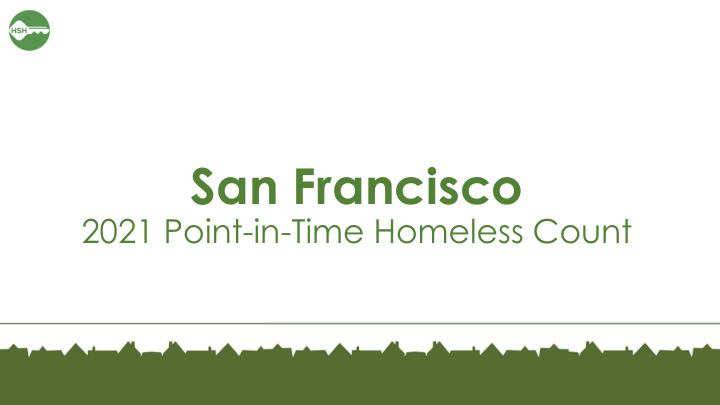



San Francisco 2021 Point-in-Time Homeless Count
Agenda • Review of PIT components • Overview of prior methodology • Federal guidance • Collecting feedback for 2021
What is the Point-in-Time (PIT) Count? • The Point-in-Time Count is an effort to measure the prevalence of homelessness in our community and collect information on individuals and families residing in emergency shelters and transitional housing, as well as people sleeping on the streets, in cars, in abandoned properties, or in other places not meant for human habitation. • The count includes several components: Sheltered Count Street Count Survey Count of homeless individuals Visual count of unsheltered Interviews with sheltered and and families staying in homeless individuals and unsheltered individuals and shelters or institutions families families
Why conduct the PIT Count? Point-in-Time (PIT) Counts of all persons experiencing homelessness are required to take place during the last 10 days of January by the US Department of Housing and Urban Development. PIT Counts… • Increases community understanding of homelessness • Impacts funding for homeless services, and meets federal data reporting requirements • Generates data regarding individuals and families experiencing homelessness in our community
Who conducts the PIT Count? • HSH contracts with Applied Survey Research (ASR), to conduct the PIT Count • ASR is non-profit social research firm who has conducted the SF PIT Count since 2009 • Volunteers from the general public • Individuals with lived experience • Partners from various city departments
Street Count • What is the street count? • A visual count of the city’s unsheltered population • How is the count conducted? • Volunteer teams of 2-3 are assigned a specific route along which they count the people they see • Where does the count take place? • The count covers the entire city • When is the count? • Last 10 days in January
Sheltered Count • What is the sheltered count? • A count of individuals and families staying in shelters, transitional housing, safe havens, resource centers, stabilization rooms, residential programs, hospital, or county jails • When is the sheltered count? • The same night as the street count • How is the shelter count conducted? • A designated point of contact at each site fills out an online survey indicating the number of individuals they are serving on the night of the count
Survey • What is the survey? • Interviews are conducted with both sheltered and unsheltered homeless individuals and families • Where is the survey conducted? • Surveys will be conducted with individuals throughout the city • When is the survey conducted? • Over the course 2-3 weeks following the PIT count • How is the survey conducted? • Transitional housing surveys will be conducted by program providers • Street and emergency shelter surveys will be conducted by homeless youth and adults
Youth Count • Why conduct a separate Youth Count? • To improve data on the extent of youth homelessness. • Who conducts the Youth Count? • Trained youth counters who are currently or recently experienced homelessness • When is the Count conducted? • The same night as the street count • Is there a survey component for the Youth Count? • Yes, there are supplemental survey questions for youth
Federal Guidance • Count must occur in the last 10 calendar days of January • Count must be conducted at least biennially • Sheltered and unsheltered individuals must be included • Homeless individuals must meet HUD definitions for sheltered and unsheltered: • Sheltered: An individual or family living in a supervised publicly or privately operated shelter designated to provide temporary living arrangement (including congregate shelters, transitional housing, and hotels and motels paid for by charitable organizations or by federal, state, or local government programs for low-income individuals) 24 CFR 578.3 • Unsheltered: An individual or family living in a supervised publicly or privately operated shelter designated to provide temporary living arrangement (including congregate shelters, transitional housing, and hotels and motels paid for by charitable organizations or by federal, state, or local government programs for low-income individuals). 24 CFR 578.3 So Source: https://files.hudexchange.info/resources/documents/PIT-Count-Methodology-Guide.pdf
LHCB Feedback post 2019 • Street Count Feedback • Change timing of the count from night to day or early morning • Use trained counters or counters with lived experience rather than (or in addition to) volunteers for the street count • Shelter & Institution Count Feedback • Incorporate the number of individuals who are “guests” in SRO’s • Incorporate families that are double- up or living in SRO’s
2021 Feedback Process • Requesting feedback from LHCB by May 2020 • hshdata@sfgov.org • HSH plans to incorporate feedback during our summer 2020 planning process • Feedback will be reviewed with an eye towards: • Feasibility • Alignment with federal requirements and standards • Data consistency • HSH will present 2021 methodology during a Fall LHCB meeting for approval
Recommend
More recommend